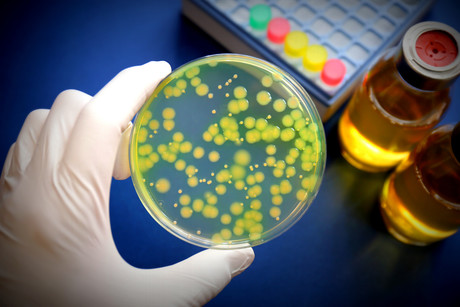Computer simulations reveal roots of antibiotic resistance

Supercomputer simulations conducted at Los Alamos National Laboratory have revealed the role of transport proteins called efflux pumps in creating drug resistance in bacteria — a breakthrough that could help improve drugs’ effectiveness against life-threatening diseases and restore the efficacy of defunct antibiotics.
Some infections do not respond to antibiotics because the efflux pumps inside Gram-negative bacteria flush out antibiotics before the drugs can work. Researchers at the Los Alamos lab chose to focus on the pumps located inside the bacteria Pseudomonas aeruginosa, which can cause serious illnesses such as pneumonia and sepsis.
In P. aeruginosa, the major pump type is called MexAB-OprM and is composed of three proteins: MexA, MexB and OprM. Only ever studied in parts, the pump encompasses both inner and outer membranes found in Gram-negative bacteria and connects the cell’s interior and periplasm (the compartment between both membranes) to the cell’s exterior. That connection creates a path for drug molecules to exit the cell.
“This is a really, really large system — approximately a million and a half atoms,” said Los Alamos theoretical biologist Cesar A López. It was therefore a significant moment when the laboratory’s supercomputers successfully performed the first atomistic simulations of the entire MexAB-OprM pump embedded within a double membrane system on a microsecond time scale.
The researchers used the simulations to investigate the dynamics of the assembled pump and to understand how pump functionality arises from these dynamics. The amino acid interactions that stabilise the complex between MexA and OprM were also independently cross-validated using a computational technique called sequence covariation analysis by Los Alamos theoretical biologist Timothy Travers.
“This is the first time such a sequence-based technique has been applied for cross-validating the interface of a protein complex built using simulations and cryo-electron microscopy,” said Travers.
Application of these computational techniques to the multitude of efflux pumps found in different Gram-negative pathogens should allow scientists to elucidate if general mechanisms are shared among different pumps or are pump-specific. For example, perhaps the amino acid interactions that stabilise the pump structure could be targeted by drug development efforts to block pump assembly or function, thereby rendering currently defunct antibiotics effective once more.
“By understanding how the pump moves and dynamically behaves, we can potentially find a way to deactivate the pump — and antibiotics that haven’t worked in a long time may be useful again,” said Los Alamos biophysicist Gnana Gnanakaran.
The findings have been published in the journal Scientific Reports.
Drying biofluid droplets used to diagnose disease
A newly developed workflow relies on the drying process of biofluid droplets to distinguish...
Map of the developing brain opens pathways to treat Parkinson's
The comprehensive single-cell map of the developing human brain captures nearly every cell type,...
Hundreds of animal studies flagged for problematic images
Researchers found many instances of image duplication within publications, as well as across...







